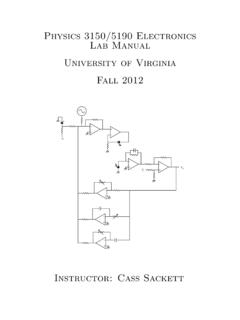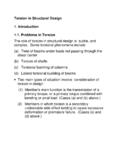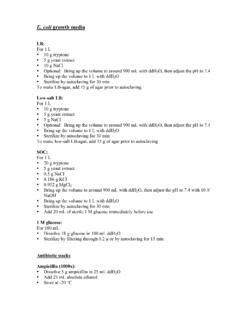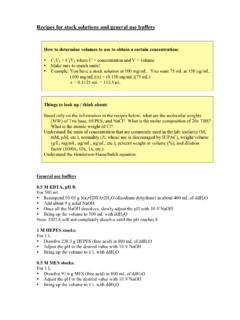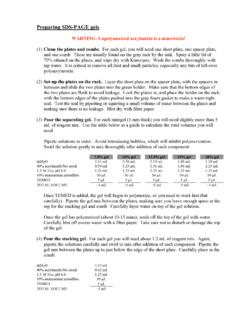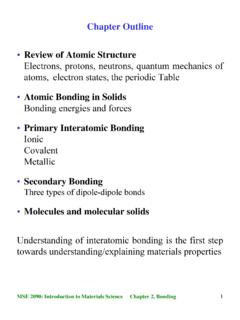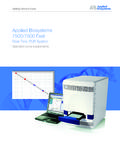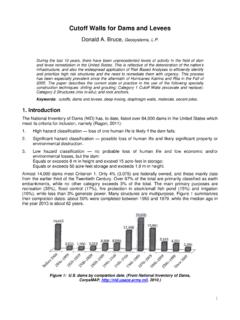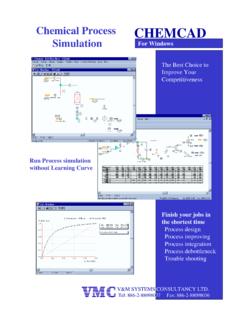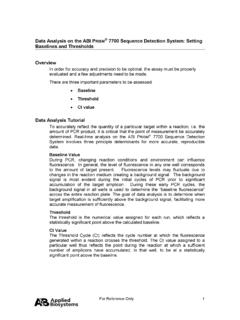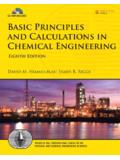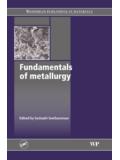Transcription of Chapter Outline: Phase Diagrams - …
1 1 MSE 2090: Introduction to Materials ScienceChapter 9, Phase DiagramsMicrostructure and Phase Transformations in multicomponent SystemsChapter outline : Phase Diagrams Definitions and basic concepts phases and microstructure Binary isomorphous systems (complete solid solubility) Binary eutectic systems (limited solid solubility) Binary systems with intermediate phases /compounds The iron-carbon system (steel and cast iron)2 MSE 2090: Introduction to Materials ScienceChapter 9, Phase DiagramsComponent- chemically recognizable species (Fe and C in carbon steel, H2O and Sucrose in sugar solution in water). A binaryalloy contains two components, a ternaryalloy three, a portion of a system that has uniform physical andchemical characteristics. Two distinct phases in a system have distinct physical and/orchemical characteristics ( water and ice, water and oil) and are separated from each other by definite Phase boundaries.
2 A Phase may contain one or more components. A single- Phase system is called homogeneous, systems with two or more phases are mixturesor : Components and Phases3 MSE 2090: Introduction to Materials ScienceChapter 9, Phase DiagramsSolvent- host or major component in solution,solute-minor Limitof a component in a Phase is the maximum amount of the component that can be dissolved in it ( alcohol has unlimited solubility in water, sugar has a limited solubility, oil is insoluble). The same concepts apply to solid phases : Cu and Ni are mutually soluble in any amount (unlimited solid solubility), while C has a limited solubility in Fe. Definitions: Solubility Limit4 MSE 2090: Introduction to Materials ScienceChapter 9, Phase DiagramsMicrostructureThe properties of an alloy depend not only on proportions of the phases but also on how they are arranged structurally at the microscopic level.
3 Thus, the microstructure is specified by the number of phases , their proportions, and their arrangement in of cast IronPhase Diagrams will help us to understand and predict microstructures like the one shown in this pageThe long gray regions are flakes of graphite. The matrix is a fine mixture of BCC Fe and Fe3C (link is dead)5 MSE 2090: Introduction to Materials ScienceChapter 9, Phase DiagramsA system is at equilibriumif at constant temperature, pressure and composition the system is stable, not changing with time. Equilibrium is the state that is achieved given sufficient time. But the time to achieve equilibrium may be very long (the kinetics can be slow) that a state along the path to the equilibrium may appearto be stable. This is called a metastable state.
4 In thermodynamics the equilibrium is described as a state of a system that corresponds to the minimum of thermodynamic function called the free energy. Thermodynamics tells us that:Equilibrium and Metastable States Under conditions of a constant temperature and pressure and composition, the direction of any spontaneous change is toward a lower free energy. The state of stable thermodynamic equilibrium is the one with minimum free energy. A system at a metastable state is trapped in a local minimum of free energy that is not the global EnergyArrangement of atoms6 MSE 2090: Introduction to Materials ScienceChapter 9, Phase DiagramsPhase diagramis a graphical representation of all the equilibriumphases as a function of temperature, pressure, and one component systems, the equilibrium state of the system is defined by two independent parameters (P and T), (T and V), or (P and V).
5 Phase diagramPressure-temperature Phase diagram for H2O:7 MSE 2090: Introduction to Materials ScienceChapter 9, Phase DiagramsPVT surface of a pure (1-component) ~campbell/ 2090: Introduction to Materials ScienceChapter 9, Phase DiagramsA pure substance is heated at constant pressureTTbV9 MSE 2090: Introduction to Materials ScienceChapter 9, Phase DiagramsPressure-temperature Phase diagram for carbonWe can see graphite, diamond, liquid carbon on the Phase but where are fullerenes and nanotubes? 10 MSE 2090: Introduction to Materials ScienceChapter 9, Phase DiagramsA Phase Diagrams show what phases exist at equilibrium and what Phase transformations we can expect when we change one of the parameters of the materials are almost always mixtures of different elements rather than pure substances: in addition to T and P, compositionis also a will limit our discussion of Phase Diagrams of multi-component systems to binary alloys and will assume pressure to be constant at one atmosphere.
6 Phase Diagrams for materials with more than two components are complex and difficult to represent. An example of a Phase diagram for a ternary alloy is shown for a fixed T and P Diagrams for binary systemsternary Phase diagram of Ni-Cr-Fe11 MSE 2090: Introduction to Materials ScienceChapter 9, Phase DiagramsIsomorphous system -complete solid solubility of the two components (both in the liquid and solid phases ). Binary Isomorphous Systems (I)Three Phase region can be identified on the Phase diagram: Liquid (L) , solid + liquid ( +L), solid ( )Liquidus line separates liquid from liquid + solidSolidusline separates solid from liquid + solid + L L12 MSE 2090: Introduction to Materials ScienceChapter 9, Phase DiagramsBinary Isomorphous Systems (II)Example of isomorphous system : Cu-Ni(the complete solubility occurs because both Cu and Ni have the same crystal structure, FCC, similar radii and electronegativity).
7 13 MSE 2090: Introduction to Materials ScienceChapter 9, Phase DiagramsBinary Isomorphous Systems (III)In one-component system melting occurs at a well-defined melting multi-component systems melting occurs over the range of temperatures, between the solidus and liquidus lines. Solid and liquid phases are at equilibrium with each other in this temperature range. + L Lliquid solutionliquid solution +crystallites ofsolid solutionpolycrystalsolid solutionLiquidusSolidusAB20406080 Composition, wt %Temperature14 MSE 2090: Introduction to Materials ScienceChapter 9, Phase DiagramsInterpretation of a binary Phase diagramsFor a given temperature and composition we can use Phase diagram to determine:1) The phases that are present2) Compositions of the phases3) The relative fractions of the phasesFinding the composition in a two Phase region:1.
8 Locate composition and temperature in diagram 2. In two Phase region draw the tie lineor isotherm 3. Note intersection with Phase boundaries. Read compositions at the intersections. The liquid and solid phases have these 2090: Introduction to Materials ScienceChapter 9, Phase DiagramsThe lever ruleFinding the amounts of phases in a two Phase region:1. Locate composition and temperature in diagram 2. In two Phase region draw the tie line or isotherm 3. Fraction of a Phase is determined by taking the length of the tie line to the Phase boundary for the other Phase , and dividing by the total length of tie lineThe lever rule is a mechanical analogy to the mass balance calculation. The tie line in the two- Phase region is analogous to a lever balanced on a fulcrum.
9 W + W16 MSE 2090: Introduction to Materials ScienceChapter 9, Phase DiagramsDerivation of the lever ruleWL= (C -Co) / (C -CL)1) All material must be in one Phase or the other:W + WL= 12) Mass of a component that is present in both phases equal to the mass of the component in one Phase + mass of the component in the second Phase :W C + WLCL= Co3) Solution of these equations gives us the lever rule. W = (Co -CL) / (C -CL)17 MSE 2090: Introduction to Materials ScienceChapter 9, Phase DiagramsPhase compositions and amounts. An fractions: WL= S / (R+S) = (C -Co) / (C -CL) = = R / (R+S) = (Co -CL) / (C -CL) = 35 wt. %, CL= wt. %, C = wt. %18 MSE 2090: Introduction to Materials ScienceChapter 9, Phase DiagramsDevelopment of microstructure in isomorphous alloysEquilibrium (very slow) cooling19 MSE 2090: Introduction to Materials ScienceChapter 9, Phase DiagramsDevelopment of microstructure in isomorphous alloysEquilibrium (very slow) cooling Solidification in the solid + liquid Phase occurs gradually upon cooling from the liquidus line.
10 The composition of the solid and the liquid change gradually during cooling (as can be determined by the tie-line method.) Nuclei of the solid Phase form and they grow to consume all the liquid at the solidus 2090: Introduction to Materials ScienceChapter 9, Phase DiagramsDevelopment of microstructure in isomorphous alloysFast (non-equilibrium) cooling21 MSE 2090: Introduction to Materials ScienceChapter 9, Phase DiagramsDevelopment of microstructure in isomorphous alloysFast (non-equilibrium) cooling Compositional changes require diffusion in solid and liquid phases Diffusion in the solid state is very slow. The new layers that solidify on top of the existing grains have the equilibrium composition at that temperature but once they are solid their composition does not change.

